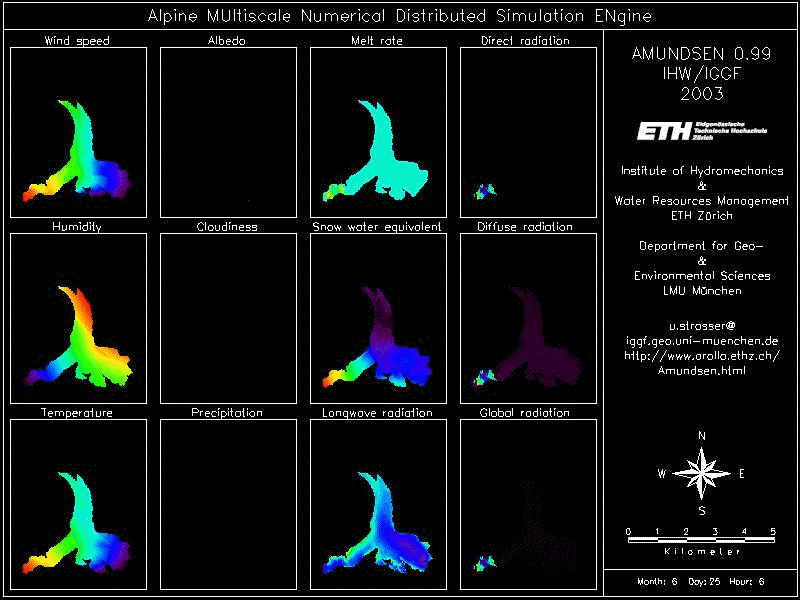
AMUNDSEN is a new scientific software tool to derive time series of spatially variable fields applying a wide range of interpolation and parameterization procedures. Its potential applications cover the simulation of physical processes in glaciology, hydrology, climatology and other alpine research fields.
This animated gif illustrates the real-time visulization of interpolated/simulated fields for the Arolla glacier catchment (Swiss Alps) (475x595 data pixels, 5 times reduced for display).

The basic considerations for the design of AMUNDSEN include:
- platform independence
- scale independent raster & vector data capability
- easy input of standard ASCII data
- automatic setup of geometry and resolution from the DTM
- full consideration of spatial and temporal variability
- simple interface to plug in physically based models
- straightforward integration of remote sensing data
- real time visualization of the computed fields
- fast computation even for high resolutions and large data sets
- OpenSource philosophy: use the framework and plug in Your model
The current and future development of the project will include:
- calculation of topographic parameters
- simulation of albedo with different parameterizations
- calculation of solar radiation
- simulation of thermal radiation
- simulation of the local wind field
- simulation of snow redistribution
- simulation of surface energy fluxes
- simulation of snow- and icemelt
- simulation of discharge
- widget-based graphical interface
AMUNDSEN is coded in IDL, a programming environment which enables a very efficient coding of vector and array manipulations and offers a large variety of visualization possibilites. IDL runs on UNIX/LINUX, Windows and Macintosh and can call external FORTRAN or C routines.
Recent changes:
| December 2001: | Slope and aspect with a vectorial algebra algorithm (Corripio 2003). VGA-size graphical display. |
| January 2002: | Color support for field display; albedo parameterization with the ageing curve approach (Rohrer 1992). |
| February 2002: | Transition to IDL 5.5; new elevation-dependent interpolation routines (inverse distance, kriging, linear, minimum curvature, modified Shepard's, natural neighbour, nearest neighbour, polynomial regression, quintic, radial basis function) (Strasser & Mauser 2001). Position of the sun (Corripio, 2003). |
| March 2002: | SVAG-size graphical display; statistical evaluation of the albedo simulation; potential direct irradiance (Corripio 2003). |
| April 2002: | Simulation of atmospheric attenuation of direct solar radiation, simulation of shading due to topography (Corripio, 2003). |
| May 2002: | Simulation of diffuse radiation using a skyview factor file (Corripio, 2003); reading of model parameters from a parameter file. |
| June 2002: | Output of all kind of results for a single point location in an ASCII-file with hourly resolution; output of solar radiation model results with hourly resolution. |
| July 2002: | Simulation of longwave (thermal) radiation (Prata, 1996). |
| February 2003: | Simulation of snowmelt with a new, enhanced temperature index melt model considering albedo (Pellicciotti et al. 2003). |
| Current work: | Simulation of snowmelt with an energy-balance model (Strasser et al. 2002). Implementation of a new albedo parameterization (Brock 2000). |
References
If You want to participate in the further development of the program, contact: u.strasser@iggf.geo.uni-muenchen.de